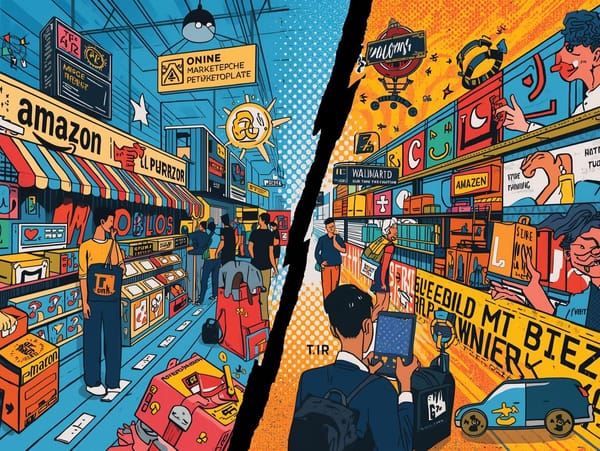Ecom Sellers: More Traffic or Better Conversion?

As an ecommerce seller, you’ve probably asked yourself a thousand times: “Do I need more traffic… or do I just need my existing traffic to convert better?”
It’s not a trivial question. Where you focus (acquisition vs. conversion) determines how you spend budget, which tools you buy, who you hire, and how you prioritize your roadmap.
In this article, we’ll break down how to think about more traffic vs. better conversion in 2025+, with practical benchmarks, examples, and a framework you can apply to your own store.
1. The macro picture: growth is harder, and waste is expensive
Ecommerce is still growing, but it’s not the wild west anymore.
For context, U.S. ecommerce sales passed an estimated $1.19 trillion in 2024 (Forbes, 2025), up about 8% year-on-year. That’s growth—but not the hypergrowth days of the 2010s. At the same time:
- Paid media (Meta, Google, TikTok) keeps getting more expensive.
- Privacy changes and signal loss make attribution fuzzier.
- Competition is fiercer, especially from marketplaces and retailers with huge first‑party data.
A recent Forbes Agency Council piece on Black Friday 2024 CRO highlighted a crucial point: brands keep pouring budget into getting more clicks, but leave huge, low‑hanging gains on the table by not improving onsite conversion first.
In other words: traffic is getting pricier; waste is getting more painful.
This is why the “traffic vs. conversion” debate matters more than ever.
2. The math: why conversion rate is a powerful growth lever
Let’s make this concrete with simple math.
Assume your current monthly numbers:
- 50,000 sessions
- 2% conversion rate
- $70 average order value (AOV)
That’s:
50,000 × 2% × $70 = $70,000 revenue/month
Scenario A: You focus on more traffic
You increase traffic by 30% (through paid ads, influencers, SEO, etc.).
- 65,000 sessions
- 2% conversion rate
- $70 AOV
65,000 × 2% × $70 = $91,000 revenue/month
→ +30% traffic, +30% revenue (before ad costs)
Scenario B: You focus on conversion rate optimization (CRO)
You keep traffic flat but improve conversion by 30%.
- 50,000 sessions
- 2.6% conversion rate
- $70 AOV
50,000 × 2.6% × $70 = $91,000 revenue/month
→ +30% CVR, +30% revenue with zero extra traffic.
Mathematically, a 30% change in either traffic or conversion rate produces roughly the same revenue lift—but improving conversion doesn’t require proportionally more ad spend.
And that’s before you factor in:
- Higher conversion → lower blended CAC
- Higher conversion → more budget you can safely reinvest into traffic later
This is why many mature brands treat CRO as a force multiplier for acquisition.
3. What the latest research says about traffic quality vs. volume
Recent data reinforces that not all traffic is equal.
- An analysis of almost 1,000 ecommerce sites found that traffic from traditional search and email still outperforms some newer channels on conversion and revenue per session. In other words, chasing volume from every new shiny source can tank your efficiency if the visitors are low intent.
- A large‑scale study of 609 million onsite searches across 113 retail sites showed that shoppers who use internal search are dramatically more likely to convert and drive a disproportionate share of revenue. This means that how traffic behaves on‑site (e.g., searching, filtering, engaging with recommendations) can matter more than the raw traffic count.
The punchline: blindly buying more traffic without optimizing onsite experience, relevance, and intent capture is a recipe for high spend and low ROI.
4. Benchmarks: when you probably have a conversion problem
Every vertical is different, but for most DTC and ecommerce brands, some rough ranges:
- New visitor conversion: 0.5–2%
- Returning visitor conversion: 2–5%+
- Add‑to‑cart rate: 5–10% of sessions
- Checkout completion (from cart): 40–70%
If your metrics are significantly below these and you’re already investing in traffic (paid + organic), odds are high you have a conversion problem, not a traffic problem.
A few common red flags:
- High traffic growth over the last 6–12 months, but flat revenue
- Paid channels with rising CPCs but no improvement in ROAS
- High add‑to‑cart but big drop‑off at checkout (e.g., shipping surprises, friction)
- Time on site is decent, but product views per user are low (navigation/search issues)
In these cases, pushing more traffic is like pouring water into a leaky bucket.
5. A simple framework: when to prioritize traffic vs. conversion
Instead of treating this as a binary choice, use a decision framework.
Step 1: Check for minimum viable traffic
If you’re under about 10,000 sessions/month, you often don’t have enough volume to run meaningful A/B tests or see clear patterns quickly.
In that early stage, you usually should prioritize:
- Getting more qualified traffic (SEO, partnerships, influencer, paid tests)
- Validating product–market fit, offers, and messaging
CRO still matters, but you’ll rely more on qualitative feedback (session replays, surveys, UX best practices) than strict testing.
If traffic is very low → focus on traffic quality and product/offer validation, with basic best‑practice UX fixes.
Step 2: Diagnose the funnel
Once you have some volume, map the funnel:
- Sessions → Product views
- Product views → Add to cart
- Add to cart → Checkout started
- Checkout started → Completed order
Ask:
- Where is the biggest drop‑off?
- Which channels convert best/worst?
- How do new vs. returning customers behave?
This diagnosis tells you what to prioritize.
Step 3: Choose your main focus for the next 90 days
Use this rule of thumb:
- Prioritize CONVERSION if:
- You already have consistent traffic (10k+ sessions/month) and some paid spend.
- Your conversion rate or checkout completion is below industry norms.
- You’ve never systematically tested your PDP, cart, or checkout.
- Prioritize TRAFFIC (acquisition) if:
- Your funnel metrics look healthy compared with benchmarks.
- You have strong repeat purchase and LTV but not enough top‑of‑funnel.
- You’re too dependent on a single channel and need diversification.
The key is to choose one primary focus per quarter, while still maintaining the other. For example, 70% of effort on CRO, 30% on new traffic tests—or vice versa.
6. High‑impact ways to improve conversion first
If your diagnosis says, “We’re leaking conversions,” here are high‑leverage areas.
6.1. Fix friction in product discovery
Given how strongly onsite search correlates with revenue, focus on:
- Clean, intuitive navigation and filters
- Fast, relevant onsite search that handles typos and synonyms
- Merchandising that surfaces bestsellers and high‑margin products
If customers can’t quickly find what they want, no amount of traffic will save you.
6.2. Strengthen your product pages (PDPs)
Small changes here can significantly lift conversion:
- Clear, benefit‑oriented headlines and descriptions
- High‑quality images and video (lifestyle + zoom/detail)
- Social proof: reviews, UGC, “as seen in,” trust badges
- Objection handling: sizing guides, ingredients, FAQs, returns
- Transparent shipping and delivery expectations
6.3. Streamline cart and checkout
Common wins:
- Offer guest checkout and clear, simple forms
- Upfront shipping costs (no nasty surprises at the last step)
- Multiple payment options (Shop Pay, Apple Pay, BNPL where appropriate)
- Autocomplete for address; remove unnecessary fields
- Trust signals and security reassurance
6.4. Capture and nurture “almost buyers”
Not everyone will convert on the first visit—but don’t waste that traffic.
- Exit‑intent offers for email/SMS capture
- Browse and cart‑abandon emails with social proof
- Personalized recommendations in follow‑up flows
This turns more of your existing traffic into revenue over time.
7. Once conversion is solid, step on the traffic gas—smartly
After you’ve lifted your baseline conversion rate, you can safely reinvest more into acquisition because each click is now worth more.
Areas to lean into:
- Paid search & social, now with stronger landing pages and offers
- SEO and content, targeting high‑intent queries your ideal buyers search
- Influencer and creator partnerships, driving traffic to optimized landing pages
- Affiliate and partnerships, where you only pay on performance
Keep measuring channel‑level ROAS and contribution margin, not just top‑line revenue. Some channels will bring high‑intent visitors who convert at 4–5%; others will flood you with cheap clicks that barely convert at 0.5%.
Double down on what sends qualified, not just plentiful, traffic.
8. The honest answer: you need both—but in the right order
So, should ecommerce sellers prioritize more traffic or better conversion?
- When you’re small and just starting: you need enough traffic to learn.
- Once you have volume: you’ll almost always get a higher ROI from improving conversion before scaling traffic.
- Long‑term winners in ecommerce treat CRO and acquisition as two sides of the same growth system.
A practical way to operationalize this:
- Set a 12‑month revenue goal.
- Model it backwards into traffic, conversion rate, AOV, and repeat rate targets.
- Identify the biggest gap between your current metrics and targets.
- Make that your primary focus for the next 90 days—either:
- Increase qualified traffic, or
- Improve conversion (or AOV/retention) so you can buy more traffic profitably.
If you get the sequencing right—fixing the bucket before turning up the tap—you’ll make every marketing dollar work harder and set your store up for sustainable growth.
Next step for you:
Take 30 minutes this week to:
- Pull last 90 days of data: sessions, conversion rate, AOV by channel.
- Compare your funnel metrics to the benchmarks above.
- Decide: is your bigger opportunity in the funnel (conversion) or at the top (traffic)?
Then commit your next quarter’s roadmap to that decision. That’s how you move from guessing to a deliberate growth strategy.



